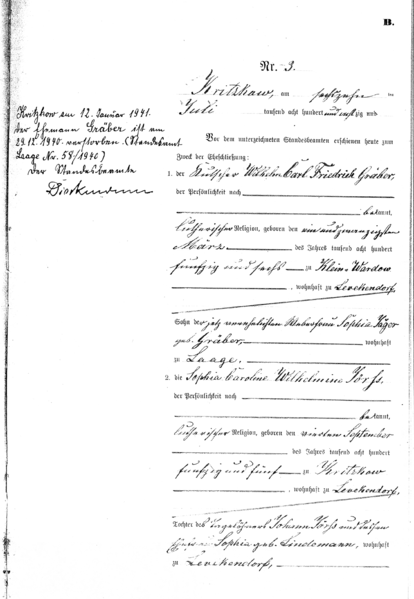Sources for genealogy: Birth-, marriage and death certificates
- 15. July 2017 - Genealogy, General, Germany, Historical Documents, Knowledge, Tips and Tricks
Some time ago we published a top-10-list of sources for genealogy in Germany on this Blog. Today, we would like to start keeping our promise by providing more information on the particular sources. Let’s get started with the civil registries.
Relevance
As we already mentioned within the top-10-blogpost, this is one of the most reliable sources. The records are kept by German public authorities via civil registry offices according to the Personenstandsgesetz (personal statute law).
The so-called Personenstandsregister (civil registries) are kept twice for reasons of legal certainty. The originals and duplicates are stored separately. Today they are replaced electronically. They contain information on births (called Geburtenregister or Geburtenbuch), Marriages (called Heiratsregister, Heiratsbücher, Eheregister or Familienbücher) as well as deaths (called Sterberegister or Sterbebücher). They include information not only on birth, marriage and death dates but in varying degrees also on the religion or profession of a person and so on. Incidental remarks may also contain notes on testaments, divorces or name changes. Not every certificate holds the same information and additional information, for example on testaments are a matter of pure luck.
Important for genealogists are, aside from the certificates themselves, the further documents that were necessary for the entries and that sometimes accompany the records (called Sammelakten). Here you may find in the case of a marriage for example birth certificates of the bridal couple, certificates of no impediment, registration certificates etc. These documents may contain information that isn’t included in the certificates themselves. But for those additional records there is no retention obligation that exceeds the periods of protection. Therefore they are often not completely preserved.
Storage and information
Until the periods of protection expire, the documents are located within the civil registry offices where you can, under certain conditions, get information as well as transcripts or certified copies (you can find more about this topic in our blogpost on periods applying to archive material). These periods are for birth certificates 110 years, for marriage certificates 80 years and for death certificates 30 years.
In Germany after these periods there is quite a variety of possibilities where you might find the records. It is different from federal state to federal state and sometimes even from city to city. Sometimes the records will stay within the civil registry offices; often they are transferred to an archive (for example a city, district or state archive). In Hamburg and Bremen they can be found in the respective state archives. Sometimes only microfilms are transferred to the archives and the originals stay within the civil registry offices, but it won’t give information anymore. In North Rhine-Westphalia the state archives in Duisburg and Detmold have departments called “Personenstandsarchiv” (civil status archives) where you can find all dublicates of the civil registries. The originals remain within the civil registry offices or a city archive. You can submit inquiries to the offices or city archives as well as to the relevant state archive. The latter has the advantage that you can search at a central location for information from more than one place.
The Standesamt I (civil registry office I) in Berlin has all the information on the former German eastern territories as well as for births, marriages and deaths of Germans abroad and of former colonies, as long as they are still within the periods of protection. All registries that are older can be found in the state archive Berlin. But especially the registries from the former German eastern territories are often incomplete due to war damages.
In case of doubt, you can usually just make inquiries at the respective civil registry offices and will be referred to the relevant archive if necessary.
History
The first, but not yet governmental, predecessors of the civil registries were the church books. Births, marriages as well as deaths were recorded here. The first that are preserved from Germany are from the 16th century, but they existed earlier. Despite their clerical nature they were also used for governmental purposes and were the basis for muster rolls, tax or census lists and so on. Sometimes there were even governmental duplicates of church books for these purposes.
In Germany, certifications for and records of births, marriages and deaths first took place on a governmental basis under French rule. If and when the French so-called Zivilstandsregister (civil registries) were introduced, was dependent on if and when the territories were occupied. On the left side of the Rhine the registers were introduced as early as 1798, on the right side only in 1808-1810. They were usually kept by the respective mayors. Sometimes the civil status registers were abolished after the end of Napoleon’s rule around 1813/14, in many regions they were continued.
In 1874, the first so-called Personenstandsregister (civil registries) of the civil registry offices were introduced in Prussia, shortly afterwards, in 1876, within the entire German Empire.
Church books were continually kept, even after the introduction of Zivilstands- as well as Personenstandsregister, but they are not the official governmental sources any more. Therefore church archives are not obligated to give information from church books for the time after 1874/1876.


0 comments